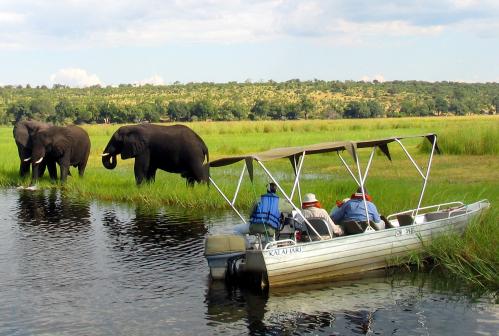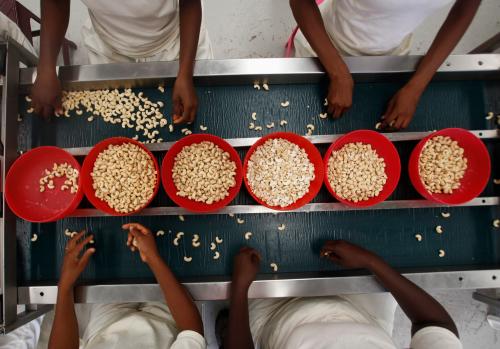Structural change is taking place in Africa, but export-led manufacturing is playing a much smaller role than it did in East Asia, and services—some with quite low productivity—now absorb the bulk of African workers leaving agriculture and moving to cities. These differences in structural change reflect the impact of technological progress, a changing global marketplace, and natural resource endowments on Africa’s industrialization prospects.
At the same time, reductions in transport costs and progress in information and communications technology have created services and agribusinesses that share many firm characteristics with manufacturing. Like manufacturing, these activities are tradable and have high value-added per worker. They have the capacity for learning and productivity growth, and some exhibit scale and agglomeration economies. We have called these emerging activities “industries without smokestacks” (IWOSS), to distinguish them from traditional, “smokestack” industry. Our prior research shows that many African economies are turning to IWOSS to lead structural change.
As part of the Brookings Africa Growth Initiative and partners’ work on the job creation potential of IWOSS, I examine country-level constraints to the growth of IWOSS sectors in a recent framing paper. A summary of the paper is below. We have also published accompanying papers on the employment elasticities of IWOSS sectors and skills requirements and gaps in those sectors. All three framing papers set the groundwork for forthcoming country case studies.
Constraints to growth
The constraints to growth analysis is built around four drivers of industrial location that have largely shaped the global distribution of industry—the “investment climate,” exports, agglomeration, and firm capabilities. Because industries without smokestacks share firm characteristics with manufacturing, the same drivers of locational choice—which are interdependent and mutually reinforcing—apply to them. Details on recommended data sources for each driver are in the full paper.
The investment climate
Reliable electrical power, lower costs of transport, workers better able to perform their jobs, and competition are essential drivers of firm-level productivity. Our constraints analysis focuses on three aspects of the investment climate that are relevant to industries without smokestacks—infrastructure, skills, and the regulatory environment. Although the “investment climate” has come to be broadly and somewhat vaguely defined, it sets the physical and institutional environment within which firms must operate.
Infrastructure. The productivity penalty that African manufacturing firms pay because of poor infrastructure has been extensively documented. Reliable electrical power may be the greatest single constraint. Transport follows as a close second. Infrastructure deficiencies also constrain the growth of tradable services. High-speed data transmission is critical to information technology (IT)-intensive exports, and IT plays a significant role in tourism. Successful agribusiness exporting requires logistics infrastructure that facilitates rapid shipment of products and information and communications technologies that support coordination between enterprises.
Skills. Some industries without smokestacks rely heavily on post-primary level skills. For example, the IT-enabled services industry is frequently constrained by the lack of university graduates with relevant language skills. The skills needed to interact with tourists and to provide the many “back office” services that are inputs into the production of high-quality tourism are essential to its further development.
Regulation. The forthcoming country studies in this project should undertake a systematic review of the regulatory environment affecting both international and domestic competition. Import competition, for example, can discipline local manufacturers and service providers. Poorly designed regulations may limit competition. Lack of competition in transport markets is associated with higher trucking costs, and “package booking” reduces competition in tourism by conferring substantial market power on lead distribution firms.
Exports
For most countries in Africa, export markets represent the best opportunity for rapid growth of manufacturing, agribusiness, and tradable services. Because firms—in both manufacturing and tradable services—face high fixed costs of entering export markets, African governments need to develop an “export push” package of trade and exchange rate policies, public investments, regulatory reforms, and institutional changes aimed at increasing the share of nontraditional exports in GDP. Understanding how the trade and exchange rate regime of a country influences the incentives for nontraditional exports and how well the institutional framework to offset anti-export bias functions can inform policies to enable IWOSS exports and thus sector growth.
Agglomeration
Like manufacturing, industries without smokestacks benefit from agglomeration economies arising from thick labor markets, information and knowledge spillovers, and the ability to share overhead expenses and services. Agglomerations pose a collective action problem which governments can address by concentrating investments in high-quality institutions, social services, and infrastructure in a limited area, such as a special economic zone (SEZ). A number of African countries—Ethiopia, Ghana, Nigeria, and Tanzania, among them—are attempting to promote a new generation of SEZs, including agribusiness. An evaluation of current SEZ programs and government efforts to promote SEZs, especially in IWOSS sectors, can identify effective strategies for growing and utilizing SEZs for IWOSS going forward.
Firm capabilities
Globally, firms are competing in capabilities—especially when trying to enter value chains with high productivity and quality standards—and those economies that succeed in attracting or developing higher capability firms are at a competitive advantage. A mapping exercise around firm capabilities in IWOSS sectors—with special attention on horizontal and vertical linkages to domestic firms, long-term relationships with domestic suppliers and customers, and spillover activities—can shed light on effective strategies to build and disseminate firm capabilities in IWOSS sectors.
Conclusion
Our research seeks to widen the options for structural change and job growth in Africa, especially among the young. Identifying the constraints to the growth of manufacturing, tradable services, tourism, and agribusiness is an essential first step in the design of an appropriate policy response.
The Brookings Institution is committed to quality, independence, and impact.
We are supported by a diverse array of funders. In line with our values and policies, each Brookings publication represents the sole views of its author(s).








Commentary
Industries without smokestacks: Constraints to growth
May 28, 2020